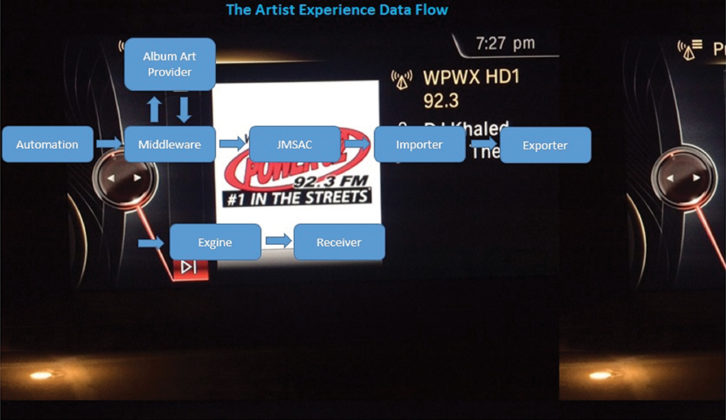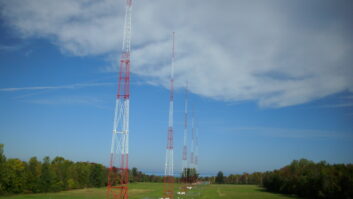Two years ago, we set about putting HD Radio graphics on WPWX and then later WSRB. Our primary purpose was to open a new revenue stream for the stations. It was also important to make sure we had a good appearance on all the dashboards that newer vehicles are incorporating on an ever-increasing basis.
If you don’t at least have your station logo on the HD graphics, the display will usually put up some default graphic like a radio tower along with the frequency. We not only wanted to have the station logos plus sponsorship logos, but album artwork as well.

We chose to use Center Stage RDS from Arctic Palm as our middleware for this application. We had heard that it was the software with the most flexibility. It turns out that Artic Palm was also purchased by DTS, which eventually became owner of iBiquity (Xperi). This is definitely a plus, since we would be able to work with support that knows the middleware through the end product in the importer, exporter and exgine.
For album art, we used the NextRadio TagStation service. This worked by sending your artist and title information to TagStation, which they used to display album art on the NextRadio app, and then they sent it back to your middleware, which eventually displayed the album art on the HD Radio.
GOODBYE, TAGSTATION
This was all working fine until last October, when we heard that TagStation was probably going to discontinue the service soon due to lack of financial support. That left us wondering where this technology was headed. I immediately emailed support at Xperi to see if they had a plan to replace this service. The word was that they were working on it.
Then, in the middle of December, TagStation officially announced that album art service would stop. Again, the word from Xperi support was that they were working on a solution. So at that point, we were without album art.
At that time, both stations had a year-long sponsor whose logo would appear on the dashboard whenever album art would not display. Obviously, this sponsor was now on the dashboard 24/7. This probably sounds favorable to the advertiser, but in my opinion, it is probably better not to have a static logo up constantly, because eventually to the viewer/listener, it just blends into the background. I feel it is a much better atmosphere for the advertiser where there is a dynamic experience that causes the advertiser artwork to stand out.
In early January, we got word that Arctic Palm was coming out with an update to the Center Stage middleware that would include album art with their service called The Connected Car. This is interesting because I always thought of the “connected car” implying that the car was connected to the internet. In this instance, for HD Radio graphics, there is no internet required. I guess you could make the case there was an indirect connection from the internet through the radio station’s digital data stream.
In order to get the new update for the Center Stage software, we had to update our support license. This is a nice way of saying we had to pay for support again. Once we did that, we updated the software and entered the login credentials for The Connected Car service, and we had the album art displaying again.
At first, the artwork display seemed very sporadic. Perhaps, this was due to Arctic Palm still building their database of artwork, or maybe it took a while to meet demand of the station sending the artist and title information for that artwork to become a part of their database. Whatever the case, I have seen an increase in the amount of songs that have the album art accompanying them on the display.
It appears to work the same way as TagStation in that the middleware sends the artist and title to The Connected Car, and then the album art is sent back for display. The one thing that I noticed that is different between the two services is that The Connected Car stores the album art for a much longer period than TagStation used to do.
Formerly, the associated JMSAC — the Multiport Sync and Async Client used to communicate between the importer and middleware — had a folder on the middleware computer called “Work.” In that folder, you would find the station logo, sponsor logo and artwork for upcoming songs. Once used, the song artwork would be deleted. The Connected Car update now uses a folder with the station call sign and the word “art” for folder name. For instance, one of our folders is named WPWX ART.
The difference I noted is that the Album Art persists much longer than before. Instead of graphics being deleted after their time is done, the software is storing them for later display. For how long, I haven’t figured out yet. But it seems smart to me that they have it ready to go. It probably places less demand on the bandwidth that Xperi has to maintain for all the stations to which it is sending artwork. I would guess server infrastructure would be less under this scenario as well, if the middleware for each station looks to find the artwork first on the local folder.
Finally, this probably makes it quicker for the process of sending the artwork from the middleware to JMSAC, importer, exporter, exgine and then the consumer’s HD Radio receiver. This all has to happen before the song actually plays on the radio. The HD Radio actually stores the upcoming artwork in its memory and then displays it when it gets the command from the exgine to display. The bandwidth that is used in the HD signal is not that great. So, anything that makes this process faster will make the artwork get there on time.
We were without album art for a little more than a month at Crawford-Chicago; it’s good to have it back. I think it is imperative for terrestrial radio to have a sharp-looking display on the center point of the dashboard. There is and will be an ever-increasing competition for this important part of new vehicles.
Rick Sewell is engineering manager at Crawford Broadcasting Company in Chicago.
Comment on this or any story. Write to [email protected].












